
Catalog excerpts
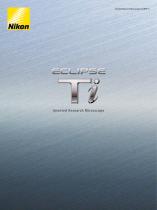
Inverted Research Microscope ECLIPSE Ti Inverted Research Microscope
Open the catalog to page 1
At the Center of Your Research Discoveries New Ti-LAPP system modular illuminators provide incredible flexibility and expandability in imaging capabilities. Microscopes are critical tools for cutting-edge research in biology, physics, pharmaceutical sciences and medicine. To meet the demands of today’s high-end research, Nikon has developed the Ti series of microscopes. Combined with NIS-Elements imaging software, the Ti enables diverse image acquisition and analysis methods such as multi-dimensional time-lapse imaging to acquire temporal, spatial and spectral information of fast, dynamic...
Open the catalog to page 2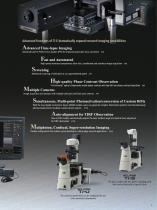
Advanced functions of Ti-E dramatically expand research imaging possibilities Advanced Time-lapse Imaging Advanced built-in Perfect Focus System (PFS) for improved automatic focus correction P4 High-speed motorized components allow fast, coordinated and seamless image acquisition P6 Multimode scanning of well plate at an unprecedented speed P7 High-quality Phase Contrast Observation “Full intensity” optical components enable phase contrast with high NA non-phase-contrast objectives P8 Multiple Cameras Image acquisition and analysis with multiple side ports and back port cameras P9...
Open the catalog to page 3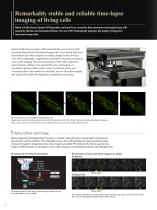
Remarkably stable and reliable time-lapse imaging of living cells Nikon's Perfect Focus System (PFS) provides real-time focus correction that overcomes microscope focus drift caused by thermal and mechanical effects. The use of PFS dramatically improves the quality of long-term time-lapse image data. Nikon's Perfect Focus System (PFS) automatically corrects focus drift caused by thermal and mechanical changes that occur during long-term observations and when reagents are added. Images remain in focus even when using higher magnification and higher resolution techniques such as TIRF imaging....
Open the catalog to page 4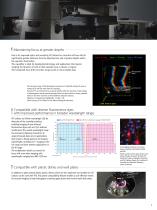
Maintaining focus at greater depths Due to its improved optics and sensitivity, PFS allows for correction of focus drift at significantly greater distances from the objective lens and at greater depths within the specimen than before. This capability is ideal for developmental biology and applications that require studying the dynamics of cells in thick samples such as tissues or organs. This broadened focus drift correction range results in more reliable data. 3D time-lapse image of the developing vasculature of a zebrafish embryo (Z-series is imaged at 95-186 µm away from the coverslip)....
Open the catalog to page 5
High-speed Motorized Control and Acquisition The synchronized control of motorized components allows researchers to use the microscope for a wide range of automated multi-dimensional experiments. Faster device movements and image acquisition minimizes unnecessary light exposure to the specimen and subsequent phototoxicity, resulting in more accurate and reliable data. Enhanced speed of individual motorized components Operation and/or changeover speed of objectives, filter cubes, XY stage, and excitation/barrier filters have been greatly enhanced, enabling a stress-free operational...
Open the catalog to page 6
Remarkably Fast Image Acquisition! Screening image capture of 96 wells in three modes (two-channel fluorescence and phase contrast) is possible at a speed of more than twice that of conventional models. Multipoint snapshots of HeLa cells transiently expressing Venus-tubulin and mCherry-actin and stained with Hoechst33342 and DiD. (All in pseudo-color) Photos courtesy of: Dr. Kenta Saito, Research Institute for Electronic Science, Hokkaido University and Dr. Takeharu Nagai, The Institute of Scientific and Industrial Research, Osaka University
Open the catalog to page 7
High-quality Phase Contrast Images with High NA Lens With Nikon’s unique “full intensity” external phase contrast unit, a phase ring is incorporated in the microscope body instead of the objective lens enables the acquisition of uncompromised, full-intensity fluorescence images as well as phase-contrast images with high-NA objectives that do not contain phase rings. Phase ring is incorporated in the microscope body Incorporating a phase ring—that was normally positioned within the phase contrast objective lens—into the external phase contrast unit optically allows use of specified high NA...
Open the catalog to page 8
Multiport and Stratum Structure Support Advanced Research Multiple image port design with left, right, and bottom* ports for optical output enables a camera or detector to be attached to each port. Furthermore, the expanded space stratum structure enables addition of an optional back port. These features allow simultaneous image capture with multiple cameras using two-tier epi-fluorescence cube turrets. *Available with Ti-E/B and Ti-U/B models with bottom port Back port enables multiple camera imaging Use of an optional back port expands the image capture capability. Used in combination...
Open the catalog to page 9
Use of Optimal Optical Technology for Each Observation Method Allows Uncompromised Image Capture Nikon’s uncompromising optical technologies provide diverse multi-modal visual information of a specimen using any observation method, delivering the full range of cellular details to researchers. Nikon Advanced Modulation Contrast Nikon has developed dedicated objectives for advanced modulation contrast. Colorless and transparent samples can be observed in high relief with a plastic dish, which is not possible in DIC observation. The direction of contrast can be matched to S Plan Fluor ELWD...
Open the catalog to page 10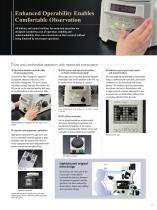
Enhanced Operability Enables Comfortable Observation All buttons and control switches for motorized operation are designed considering ease of operation, visibility and understandability. Users can concentrate on their research without being hindered by microscope operations. Fast and comfortable operation with motorized components ● peration buttons on both sides O of microscope body ● VFD screen and operation buttons on front of microscope body ● Remote control pad touch panel and preset buttons Fluorescence filter changeover, objective changeover, objective retraction, Z-axis coarse/fine...
Open the catalog to page 11All Nikon Instruments catalogs and technical brochures
-
Super Resolution Microscopes
28 Pages
-
HCA
8 Pages
-
DS-Fi3
16 Pages
-
ShuttlePix
8 Pages
-
A1 MP+ / A1R MP
15 Pages
-
A1 HD25 / A1R HD25
15 Pages
-
TI-E
32 Pages
-
ECLIPSE TS2
8 Pages
-
ECLIPSE TS2R
8 Pages
-
N-SIME
6 Pages
-
N-SIM N-STORM
24 Pages
-
ECLIPSE E100 LED
8 Pages
-
Bio Station IMQ
8 Pages
-
ECLIPSE Ti2
24 Pages
-
A1 MP+ / A1R MP+
20 Pages
-
DIGITAL SIGHT SERIES
16 Pages
-
Eclipse LV100N-POL Ci-POL
8 Pages
-
ShuttlePix Brochure
5 Pages
-
NeoScope Brochure
16 Pages
-
Eclipse FN1
12 Pages
-
C2 Plus
16 Pages
-
A1+ / A1R+
13 Pages
-
Biological Microscopes
24 Pages
-
Stereomicroscopes
32 Pages
-
SMZ18
16 Pages
-
N-SIM E
4 Pages
-
N-STORM 4.1
13 Pages
-
A1_MP
11 Pages
-
AZ_C1
2 Pages
-
MiBrochure
2 Pages
-
A1+_A1R+_2CE-SBTH-9
13 Pages
-
C2+_2CE-SCHH-5
16 Pages
-
High Content Microscopy
2 Pages
-
NIS-Elements
8 Pages
-
Digital Sight Series
9 Pages
-
ShuttlePix P-400R
5 Pages
-
AZ100M
8 Pages
-
AZ100
4 Pages
-
Eclipse E200POL
3 Pages
-
Eclipse LV100ND POL/DS
2 Pages
-
Eclipse E100 LED
4 Pages
-
Eclipse Ci-E/ Ci-L
5 Pages
-
Eclipse Ni
15 Pages
-
Eclipse E200 POL
3 Pages
-
Biological Microscopes
12 Pages
-
ECLIPSE LV100N POL 50i/ POL
4 Pages
Archived catalogs
-
Digital Sight Series Brochure
16 Pages
-
Eclipse E100-LED
8 Pages
-
A1 MP+ / A1R MP+
11 Pages




















































